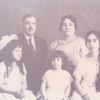Disclaimer
This entry contains information known to us from a variety of sources but may not include all the information currently available. Please be in touch if you notice any inadvertent mistakes in our presentation or have additional knowledge or sources to share. Thank you.
Archive
Moses Somake: Mules Mansion at Karachi, Pakistan
Mules Mansion sits on one of the busiest roads in Karachi. Built by the Iraqi Jewish architect Moses Somake in 1917, it blends Renaissance and Anglo-Oriental methods into a distinctive style. While Mules Mansion has long been one of the grandest and most recognizable buildings in the city, today it is little more than a picturesque ruin. Virtually empty except for a few small shops, the building’s exterior has been eaten away by pollution and dust. Distemper paint stains the walls of the ground floor yellow, and the aftereffects of a fire on the top floor are still clearly visible. According to one visitor, the building has “a bereaved look”.1
Description
Moses Somake Although Moses Somake’s buildings are among the most famous and recognizable in Karachi, little is known about the architect who designed them. Somake was born on June 6, 1875, possibly in Lahore. Sources describe him as an Iraqi Jew, but differ as to whether he was born in Iraq or was of Iraqi heritage but born in India. He spent most of his life in Karachi before emigrating to England in the mid 1940s, and died on April 6, 1947.2 During his years in Karachi he designed over a dozen buildings, including mansions, hotels, and a mosque that was never built.3 Many of the buildings still remain: some, including the Karachi Goan Association Hall and the BVS Parsi School, still fulfill their original purpose, while others are neglected or have fallen into disuse. Even the buildings that are virtually abandoned are still recognized as some of Karachi’s most beautiful and striking landmarks, emblematic of a style described as “hauntingly beautiful”.4 Somake’s buildings preserve the past through their uses as well as their designs, recalling the greater religious diversity that existed in Karachi in the early 20th century, when a Jewish architect could be commissioned to design a mosque, a building for a predominantly Christian club, and a school for Zoroastrian students.
History In 1917, Fakirji Cowasjee, a Parsi businessman, commissioned the building that would become Mules Mansion.5 The Cowasjees own the building to this day, despite the diverse array of uses it had been put to in almost a century of existence. Initially it housed the Karachi Port Trust, and takes its name from Sir Charles Mules, the first fulltime chairman of the Trust.6 After the partition of India, it served as Pakistan’s naval headquarters, and then was converted to a residential building. Currently, Mules Mansion remains mostly residential, with a few shops on the ground floor. The building is in need of serious repair due to the effects of pollution and dust, as well as the distemper paint applied to the ground floor exterior and the fire that gutted the top floor several years ago.7 Although Mules Mansion badly needs cleaning and renovation, the current tenants don’t even pay their rent, according to Cyrus Cowasjee, the owner.8 The building remains striking, but the effects of pollution and neglect have dulled its beauty.
Karachi's Jewish Community In the early 19th century, Jews of the Bene Israel communities in India migrated to Indian costal towns, including Karachi. By the 1890s, Karachi had a thriving Jewish population; the city’s Magan Shalome synagogue was constructed in 1893.9 The Jewish community played a role in shaping Karachi’s development—whether through the physical development of the city, as architect Moses Somake’s buildings transformed the landscape, but or through political influence. Two prominent members of the Jewish community in the early 20th century were heavily involved in Karachi’s government. Solomon David Omerdekar, who spearheaded the effort to construct the synagogue, held several positions in the local government, and a street named after him still exists to this day.10 Abraham Reuben served as the first Jewish city councilor, elected to the city council three times between 1919 and 1939.11 According to several accounts, Karachi in the early 20th century was a very tolerant city, with diverse religious populations coexisting peacefully.12 While the Jewish population was around 2500 at the time of partition, mass emigrations to Israel in the 1950s reduced the population to less than 300 by 1968.
Sources
[1] “Karachi Landmarks – Mules Mansion.” The Karachi Walla. June 7, 2011. Accessed July 9, 2014. http://thekarachiwalla.com/2011/06/07/karachi-landmarks-the-mules-mansion/
[2] Salman, Mohammed. “Somake’s Karachi.” Dawn.com. May 22, 2011. Accessed July 8, 2014. http://www.dawn.com/news/630841/somakes-karachi
[3] Maher, Mahim. “The Jews built Karachi, but we built shopping plazas on their synagogue.” The Express Tribune. November 3, 2013. Accessed July 8, 2014. http://tribune.com.pk/story/626468/secret-histories-the-jews-built-karachi-but-we-built-shopping-plazas-on-their-synagogue/
[4] Salman. "Somake's Karachi."
[5] Aziz, Qutubuddin. Jinnah and Pakistan. Karachi: Islamic Media Corp., 2001. 127. Accessed July 9, 2014. http://books.google.com/books?id=1wluAAAAMAAJ
[6] Ibid.
[7] "Karachi Landmarks - Mules Mansion."
[8] Salman, Peerzada. “Mansion not.” Dawn.com. June 28, 2009. Accessed July 9, 2014. http://www.dawn.com/news/474220/mansion-not
[9] Ghosh, Palash. “Karachi Yahudi: Pakistan’s vanishing (or vanished) Jewish community.” International Business Times. November 16, 2013. Accessed July 9, 2014. http://www.ibtimes.com/karachi-yahudi-pakistans-vanishing-or-vanished-jewish-community-1472832
[10] Ibid.
[11] Ibid.
[12] Ibid.



![Mules Mansion, Upper Floor Exterior [2] (Karachi, Pakistan, 2011)](https://cdn.filestackcontent.com/YVs59rToSmGainXFJzpD/convert?w=100&h=100&fit=crop)
![Mules Mansion, Upper Floor Exterior [1] (Karachi, Pakistan, 2011)](https://cdn.filestackcontent.com/tjQ7bAD8R3uGtAanoUta/convert?w=100&h=100&fit=crop)




![Mules Mansion, Exterior and Street [2] (Karachi, Pakistan, n.d.)](https://cdn.filestackcontent.com/866Ym9dSCScudKMsf8Uw/convert?w=100&h=100&fit=crop)
![Mules Mansion, Exterior and Street [1] (Karachi, Pakistan, 2011)](https://cdn.filestackcontent.com/cTxk9lWBSAGsjECCEqSd/convert?w=100&h=100&fit=crop)

